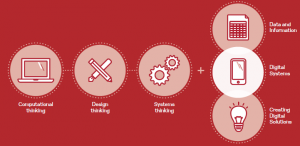The Victorian Curriculum F-10 has been designed to provide practical opportunities for students to explore the capacity of information systems to systematically and innovatively transform data into digital solutions, through the application of:
- Systems thinking – the relationship between people, digital devices and society when developing solutions.
- Design thinking – designs that are intuitive to users of all ages and abilities.
- Computational thinking – the precise steps and decisions that need to be made to code a solution
- The Digital Technologies DigiPub provides advice about the curriculum, making links to current practice and getting to know the terminology.
Curriculum Resources
- VCAA Curriculum area advice – planning documents, assessment and reporting advice.
- Digital Technologies DigiPub – Where to start, case studies, teaching resources, assessment.
- Digital Technologies Hub – step by step advice and resources for teachers, school leaders, families and students.
- Making DigiPub – creating a maker space, case studies and resources for inspiration.
- FUSE – resources linked to Victorian Curriculum content descriptions.
- Glossary of new terms – find a comprehensive glossary of important terms.
- Frequently asked questions – commonly asked questions around planning and preparing for implementation of the curriculum.
- School case studies – find out how other schools have introduced the Digital Technologies curriculum.
Professional Learning and events
- CSER Digital Technologies Education run a range of programs including a free online course in the form of a MOOC, professional learning events, the National Lending Library.
- PL-in-a-Box – professional learning packages for teachers to run their own workshops in schools.
- Digital Learning and Teaching Victoria run a range of professional learning.
- Microsoft Educator Community have courses, webinars and resources to support teachers with coding and pedagogy.
- Computational Thinking Course for Educators: Google has developed a free online course which includes topics such as exploring and developing algorithms, finding patterns and applying computational thinking to real-world problems.
- The Victorian STEM Map shows where teachers and students can access programs, events, professional learning and specialist centres, including coding challenges to support computational thinking.
- Digital Learning Professional Learning Calendar highlights upcoming virtual and face to face activities and events.
About the Digital Technologies Curriclum
The Digital Technologies curriculum is part of the new Victorian Curriculum. The Foundation to Level 10 curriculum provides a single, coherent and comprehensive set of prescribed content and achievement standards. All government and Catholic schools are required to implement and report on the Digital Technologies curriculum from 2017.
The new curriculum area should not be confused with integrating the use of ICT across all curriculum areas.
ICT across the curriculum is about students developing digital skills and knowledge to investigate, create and collaborate across all curriculum areas. They also learn safe and responsible use in managing and operating ICT.
Digital Technologies is a specific curriculum that focuses on students thought processes in order to unravel problems, and then design and generate digital solutions.
Students will learn how computers work and how to create digital solutions for real-world problems and challenges with computational thinking, which uses systematic solutions to solve problems, part of this is developing a working knowledge of coding.
Download the fact sheet for more information.
